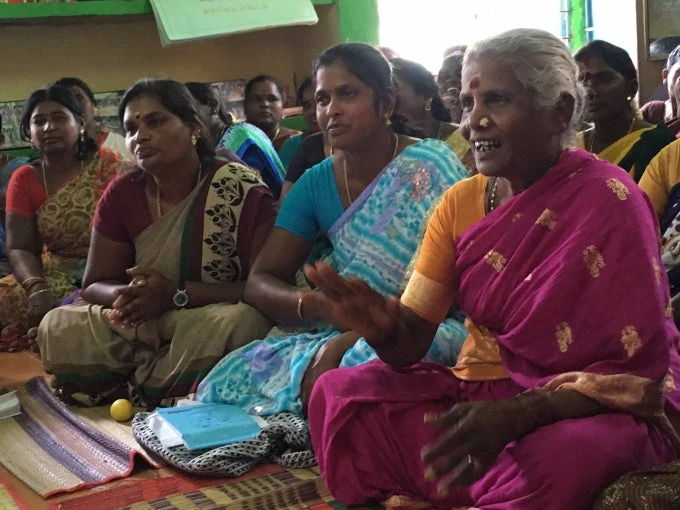In India’s southern state of Tamil Nadu, I met young ex-farmers who had moved out of farm jobs and were now working in factories and government offices. Their day to day circumstances weren’t all that different from millions of others around the world.
But yet, the people I met were remarkable. There was the disabled young man who, with skills training, found an IT job and a life outside his home, and is now supporting his mother. There were also women Self Help Group (SHG) members who, with support from their female Panchayat Leader, Pushpa, were helping to better the lives of their communities. They worked to improve water supply, build toilets and boost sanitation, and also found jobs in agro-processing.
My time in India made it clear to me that opportunity can change lives - especially in rural areas, where 78% of the country’s poor people live.
Opportunity can come in various forms. It can come in the form of social empowerment - by giving voice to groups that are often marginalized, such as women, youth and disabled people.
It can also come in the form of jobs - through skills training, job placement programs and other services that help people secure formal employment.
Jobs and social empowerment are two different opportunities. But they can be related: They both share transformative effects that are positive, and can multiply in unexpected directions.
For example, as women gain more confidence, their voices are listened to on a variety of matters within the home - such as on family planning and how to spend family incomes - improving the lives of their children and their families. Collectively, the power of their voices expressed through SHGs and other groups can bring about change on a larger scale, impacting the wider community as a whole.

Jobs, too, are known to have transformative effects. They give people the economic resources to improve their quality of life, open up new opportunities and enable them to engage with the outside world.
In the last 15 years, the Indian government has worked assiduously to create opportunities for poor rural people both within and outside farming. They began by empowering millions of people through organized groups like SHGs, and have since expanded into creating jobs both on and off the farm for hundreds of thousands of people. Through the years, the World Bank has aided the Indian government’s work in this area by supporting many of its rural programs, in addition to helping empower women and other vulnerable groups.
Altogether, India’s rural programs have helped organize 22 million women into SHGs. To put that number in perspective, the women who have been so organized make up a slightly larger group than the combined populations of Denmark, Norway and Sweden. Total SHG membership in India stands at 30 million, which means that 72% of India’s total SHG membership was enabled in part with support from Bank rural projects that have empowered women to find their voice and advocate for their communities. Bank-supported empowerment programs also focus on other vulnerable groups, including unskilled youth and disabled people.
The numbers on the jobs front are also worth highlighting. Nearly 745,000 young Indians—which is nearly equivalent to the total population of Port-au-Prince - have found jobs with the help of rural programs. Women and handicapped people have also been placed in factory jobs, government jobs, and agribusinesses. For instance, a partnership with a garment factory in Tamil Nadu has employed thousands of young women who would otherwise have stayed at home, dependent on their families for everything.
It was clear from my visit that India has made great strides in the rural arena, and is prepared to take this agenda even further. On our part, India’s successes, as well as our experiences in other countries, have taught us what makes for effective programs that empower rural people and enable them to find jobs. First, rural programs should prioritize building community institutions for rural poor people.. In India, self-help groups were particularly effective in involving women in community decision-making and project planning and implementation. Indian SHGs have also facilitated access to credit, learning and other resources and organized producers to aggregate production and boost their bargaining power with banks and agriculture product suppliers. In Palayanur Village, Tamil Nadu, one SHG provided tribal communities with school buses to bring children to school and even taught its members how to feed their families nutritiously. In other countries, the Bank has built institutions that make local governments and markets more accessible, and accountable, to smallholders and rural communities.
Second, effective rural programs should focus on developing the job ecosystem by expanding entrepreneurship and job opportunities off the farm. Today, as India’s long-time partner in creating opportunities for poor rural people, the World Bank remains committed to supporting India as it takes it rural agenda into the future. Equipping rural people with the right skills to qualify for jobs and providing business development know-how so that they can grow their enterprises is an important first step. Through the Palayanur Village SHG, more than 100 people were able to parlay their training in nursing, cheese-making driving and computer skills into jobs and income-generating livelihoods. Hundreds more across India’s countryside have had similar opportunities. It’s important to note that the Bank’s commitment doesn’t end with training—several programs have partnered with the private sector to place people in jobs.


Join the Conversation